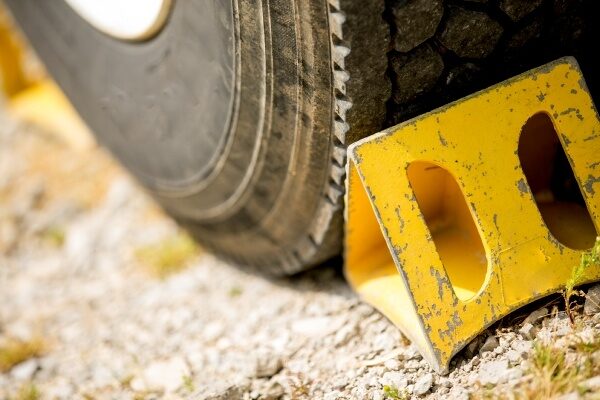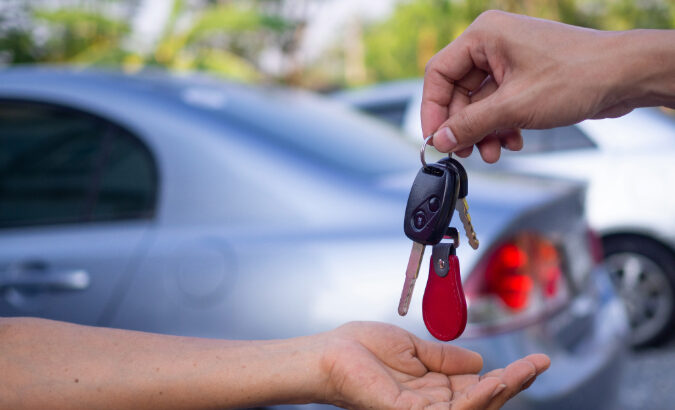
If your car has disc brakes, then you’ve got a small piece of material called a brake pad to thank every time you slow down or stop. When you press down on the brake pedal, brake pads are pushed against a disc in your tire, creating the friction that slows your car.1
This process will cause your brake pads to wear down and become less effective over time, meaning that checking and replacing them on a regular basis is a crucial part of maintaining your car. When considering how often to replace brake pads, know that it varies depending on where you drive and how liberal you are with your brake use. The average brake pad is replaced every 30,000-70,000 mile2 and costs around $150, however that number can go up or down depending on the material your pads are made of and the kind of vehicle you drive.3 A brake pad check is usually part of your routine car maintenance, but it’s best to know how to check brake pads yourself to see if they’re approaching replacement time.
1. Listen for a squealing noise when braking
Sometimes listening to the sounds your car makes is the best way to determine if something is wrong. You can always tell when to replace brake pads if your brakes start to squeak or grind every time you apply them. Many brake pads are designed with a piece of metal that is intended to create that telltale squeak once the pad has reached a certain degree of wear.4 When you hear the squeak, it’s time to take a peek.
2. Check for vibration in the brake pedal when braking
Worn down brake pads don’t just squeak, they’ll also create vibrations throughout the car that you can feel in the steering wheel and brake pedal. If you feel that vibration, it’s a sign that either your pads need to be replaced or your rotor (the disc your pads press against to create friction) has become warped. In either case, it’s time to bring your car in for servicing.5
3. Inspect brake pads through the rim of the wheel
What do brake pads look like? You can see for yourself without having to remove any part of your wheel, and in the interest of inspecting your pads’ condition, you should do so. With your car safely off and in park, have a look through your rims. You’ll see the rotor and the caliper which clamps your pads to it. Inside the caliper, you can see the brake pads. Many have a wear indicator in the center that allows you to easily measure brake pad thickness. If that wear slot is gone or barely visible, you know it’s time to take your vehicle in for new brake pads.
4. Checking the brake pads after removing the wheel
In some cases, you may have to remove your wheel to check brake pad wear. Always ensure that your car is on a level surface before doing this. Use a jack to lift the car, unscrew the lug nuts, and then remove the tire. With the wheel removed, you can more easily inspect the brake pad for excessive wear. If the pad is less than a quarter inch thick, it’s time to replace it.6
5. Have a professional mechanic inspect the brakes
If you notice any squeaking or vibrating, or you observe excessive wear upon checking your brake pads, your next step should always be to make an appointment with a professional mechanic as soon as possible. This is also an excellent opportunity to have any other routine maintenance performed that your car might require. Visit the Nationwide car depreciation calculator to make better-informed choices about maintaining and insuring your car.
Brake performance is incredibly important, and the average cost to replace brake pads can vary greatly, so it’s best to take steps to preserve yours. Maintaining a safe following distance from the car in front of you, braking gradually, and avoiding “riding the brake” are all excellent ways to take it easy on your brake pads and extend their lives.
And when fully functioning brake pads aren’t enough to avert trouble, you can always count on Nationwide for dependable auto insurance.
1https://www.bridgestonetire.com/tread-and-trend/drivers-ed/when-to-replace-brake-pads#, Accessed June 2021
2https://www.sunautoservice.com/how-often-do-you-change-brake-pads-and-rotors/, Accessed June 2021
3https://www.kbb.com/brake-repair/, Accessed June 2021
4https://www.kbb.com/brake-repair/, Accessed June 2021
5https://www.cars.com/articles/why-does-the-pedal-vibrate-when-i-hit-the-brakes-1420684416551/, Accessed June 2021
6https://www.wagnerbrake.com/parts-matter/automotive-repair-and-maintenance/how-to-check-brake-pads.html, Accessed June 2021
Disclaimer:
The information included is designed for informational purposes only. It is not legal, tax, financial or any other sort of advice, nor is it a substitute for such advice. The information may not apply to your specific situation. We have tried to make sure the information is accurate, but it could be outdated or even inaccurate in parts. It is the reader’s responsibility to comply with any applicable local, state, or federal regulations. Nationwide Mutual Insurance Company, its affiliates and their employees make no warranties about the information nor guarantee of results, and they assume no liability in connection with the information provided. Nationwide, Nationwide is on your side, and the Nationwide N and Eagle are services marks of Nationwide Mutual Insurance Company. © 2021 Nationwide.



